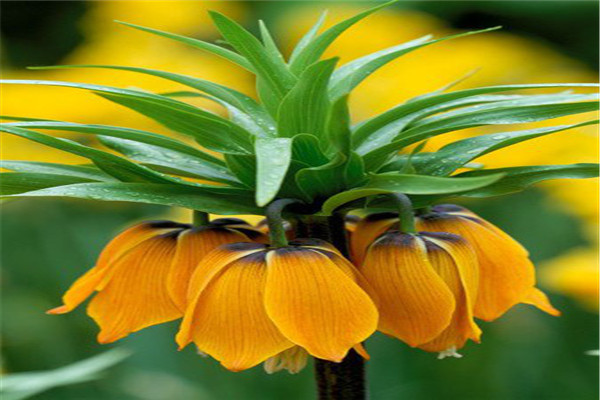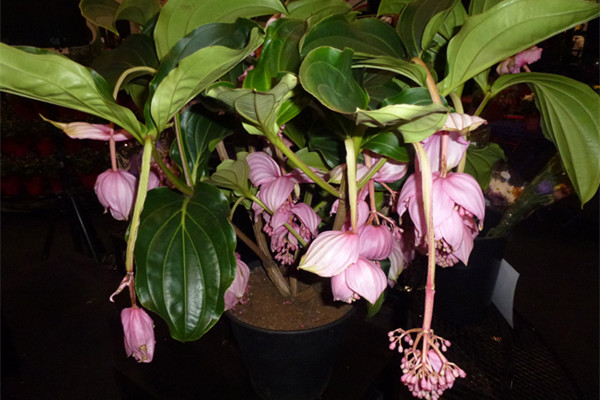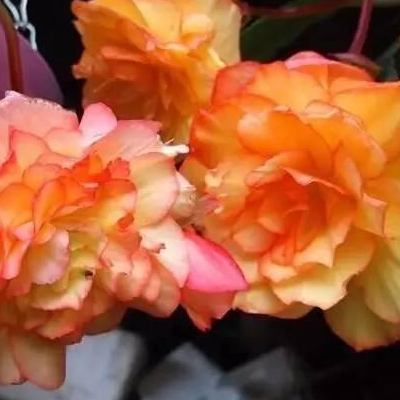How long is the florescence of Fritillaria thunbergii
Fritillaria thunbergii, this is a kind of flower that many people like very much. the flower of this Fritillaria is really good-looking. What is the breeding method of Fritillaria? How long is the florescence of Fritillaria thunbergii?

The culture method of Fritillaria thunbergii
1. Soil requirements
Fritillaria thunbergii has higher requirements for soil. The field soil for planting Fritillaria should be loose and fertile, rich in organic matter and well drained, while potted Fritillaria can use the same amount of humus soil, garden soil and sand mixed substrate.
2. Temperature requirement
Fritillaria thunbergii Yang is shade-resistant and cold-resistant, so it needs low temperature treatment. It is recommended that the temperature should be kept at 5: 9 ℃. The growth temperature of Fritillaria thunbergii is 7: 20 ℃. Fritillaria thunbergii can be collected and stored when it is dormant in summer, and the storage temperature is about 13 ℃.
3. Common diseases and their control.
The common diseases of Fritillaria thunbergii are rust and gray mold. Rust mainly occurs in the leaf back, petiole and stem base of Fritillaria thunbergii. The symptom is that there are many brown spore groups. In severe cases, Fritillaria will die in the early stage. The main method of prevention and control of rust is to strengthen management and remove residual plants in time. In order to prevent the occurrence of rust, 1000 times liquid methyl topiramate and new high lipid membrane can be sprayed before the disease. The symptom of Botrytis cinerea is that the leaf green and leaf tip of Fritillaria thunbergii appear disease spots similar to the shape of water, and wither and die if it is serious. the method to prevent and cure Botrytis cinerea is to spray the mixture of 500-fold solution of benzoammonium and new high lipid membrane.
The florescence of Fritillaria thunbergii
Fritillaria thunbergii blossoms, usually in spring, and the florescence is concentrated in April-May.
The flowers of Fritillaria are still very beautiful and bright, the colors are mainly bright red, as well as orange and yellow. Fritillaria thunbergii is of medium plant type, and the flowers generally bloom at the top of the plant, the bell-shaped flowers are usually surrounded by several flowers, and the flowers are drooping and very strange.
In addition, there are other varieties of Fritillaria, such as Fritillaria thunbergii, which have long spikes of flowers and usually bloom in early summer.
Fritillaria, also known as Michelawiki Fritillaria, has relatively small spikes and bell-shaped flowers. The florescence is in early summer.
This is the end of the introduction of the breeding method and florescence of Fritillaria thunbergii. Hurry up and have one at home. It really looks a little good.
Morphological characteristics and habits of Fritillaria thunbergii cultivation and reproduction of Fritillaria thunbergii
Fritillaria thunbergii is a perennial bulb flower, which is planted in autumn. Fresh bulb is larger, plant height is about 70 cm; stem erect, leaves ovate-lanceolate to lanceolate, entire. The plant bears flowers, several flowers are collected, and the Corolla is bell-shaped, pendulous under a group of leafy bracts. The flowers are bright red, orange and yellow, and the florescence is from March to June.
For planting Fritillaria, we should choose sandy loam with loose and fertile, rich in organic matter, good drainage and pH6.0-7.5. before planting, we should apply sufficient base fertilizer, mature organic fertilizer or fish and bone meal, and pot culture should use humus soil, garden soil and sand mixed substrate.
Fritillaria plants are traditionally cultivated as medicinal materials in China. But in the world, there are nearly a hundred species cultivated as ornamental flowers. Fritillaria thunbergii is one of the most famous and common species.
Morphological characteristics of Fritillaria thunbergii
Fritillaria thunbergii is a perennial bulb flower, fresh bulb is larger, plant height is about 70 cm; stem erect, leaves ovate-lanceolate to lanceolate, entire. The plant bears flowers, several flowers are collected, and the Corolla is bell-shaped, pendulous under a group of leafy bracts.
The flowers of Fritillaria thunbergii are bright red, orange and yellow with a florescence in May. Another wave period Fritillaria (F.persica) plant height of 80 cm, long spikes, flowering in early summer, can be used as a flower border. Fritillaria thunbergii, also known as F.michailovskyi, is 20 cm tall with thin, gray-green leaves and small, bell-shaped, drooping flowers.
The bulb has 2-3 fleshy scales, 1.5~4cm in diameter. Leaves sessile, broadly linear, 3-4 leaves whorled or opposite, apically bearded. Raceme, with 1-6 flowers, born in the axils of stem top leaves, bell-shaped, yellowish to yellowish green, with purple reticulate markings, drooping. The florescence is from March to June.
Ecological habits of Fritillaria thunbergii
Fritillaria thunbergii is positive, shade-tolerant and cold-tolerant, which requires low temperature treatment of 5: 9 ℃, about 13-17 weeks, and the growth temperature is 7-20 ℃. The soil should be moist, the drainage is good, dormancy in summer, ball collection storage, storage temperature is about 13 ℃, the Autumn Equinox ball reproduction in summer.
Cultivation techniques of Fritillaria thunbergii
For planting Fritillaria, we should choose sandy loam with loose and fertile, rich in organic matter, good drainage and pH6.0-7.5. before planting, we should apply sufficient base fertilizer, mature organic fertilizer or fish and bone meal, and pot culture should use humus soil, garden soil and sand mixed substrate. The suitable planting period is from September to October in autumn, the distance between plants is about 30cm, and the soil is covered with 8cm-12cm after planting.
Areas with cold climate need to be covered for overwintering. After the new buds are unearthed in early spring, topdressing should be applied once in time to promote the growth of stems and leaves. Keep the soil moist at ordinary times, and the flowering varieties in late spring have better shade quality. During the growth period, it is vulnerable to leaf spot disease and lily black weevil, which can be controlled by spraying 50% topazine wettable powder 700800 times and 140% omethoate EC 1000 times respectively. After the aboveground withered in summer, the soil can be left in the dormant period, but the soil should not be too wet to avoid underground bulb rot, and it can also be dug up and stored in a cool and ventilated environment for summer. Bulb rot occurs occasionally, in addition to disinfecting the bulb, Bordeaux solution can be sprayed regularly to prevent and cure it.
The mode of reproduction of Fritillaria thunbergii
Fritillaria thunbergii is propagated by dividing balls, which is often divided in summer and autumn, and the reproduction is mainly divided bulbs.
Variety classification of Fritillaria thunbergii
Main varieties
1. Halo, orange flowers, dark yellow leaf margin
2. Crown King, spend two rounds, orange and red
3. Ruthias limit, dark yellow flowers
4. Prime Minister, orange flowers with purple markings.
There are about 100 species of Fritillaria, distributed in the Northern Hemisphere, especially in the Mediterranean, southwestern Asia, western North America and so on. Common species are Fritillaria thunbergii (F.thunbergii), Fritillaria thunbergii (F.cirrhosa), Fritillaria thunbergii (F.ussuriensis), Fritillaria thunbergii (F.camtschatcensis) and so on.
The language of Fritillaria thunbergii
The language of Fritillaria: patience. Its flowers always keep their heads down, so the flower language of Fritillaria corona is patience.
Another saying that the flower Fritillaria flower language: gorgeous.
After reading the above introduction about the cultivation and reproduction of Fritillaria, do you know more about the cultivation and reproduction of Fritillaria? if you want to know more about Fritillaria, please continue to pay attention.
Introduction and cultivation management techniques of Fritillaria thunbergii
Fritillaria thunbergii (Crown Fritillaria, lily)
Scientific name: fritillaria imperialis
Families and genera: Fritillaria of Liliaceae
Morphological features: the bulb is large. Stems erect, leaves ovate-lanceolate to lanceolate, entire. The plant bears several flowers, and the Corolla is bell-shaped, pendulous under leafy bracts. The flowers are bright red, orange and yellow.
Ecological habits: positive, shade-tolerant, cold-tolerant, requiring low temperature treatment of 5: 9 ℃, about 13-17 weeks, growth temperature 7-20 ℃. The soil should be moist, the drainage is good, dormancy in summer, ball collection storage, storage temperature is about 13 ℃, the Autumn Equinox ball reproduction in summer.
Cultivation and management: choose sandy loam with loose and fertile, rich in organic matter, good drainage and ph6.0~7.5, apply sufficient base fertilizer before planting, mature organic fertilizer or fish and bone meal can be used; pot culture should use humus soil, garden soil and sand mixed substrate. The suitable planting time is from September to October in autumn, the distance between plants is about 30cm, and the soil is covered with 8cm~12cm after planting. Areas with cold climate need to be covered for overwintering. After the new buds are unearthed in early spring, topdressing should be applied once in time to promote the growth of stems and leaves. Keep the soil moist at ordinary times, and the flowering varieties in late spring have better shade quality. After the aboveground withered in summer, the soil can be left in the dormant period, but the soil should not be too wet to avoid underground bulb rot, or it can be dug up and stored in a cool and ventilated environment for summer. Bulb rot occurs occasionally, in addition to disinfecting the bulb, Bordeaux solution can be sprayed regularly to prevent and cure it.
Pest control: vulnerable to leaf spot disease and lily black weevil during growth, 50% topazine wettable powder 700 times 800 times and 140% omethoate EC 1000 times can be sprayed respectively.
Flowering: may.
- Prev

How to cut and water Baolian lantern
Baolian Lantern, this is a lot of people like this kind of flower, this Baolian Lantern looks good, how to cut Baolian Lantern? How to water Baolian Lantern: how to cut Baolian Lantern: preparation work: 1. The substrate of cutting Baolian Lantern cutting can choose mixed substrate or pure sand substrate.
- Next

The propagation method of flower bulb root of begonia which caliber to choose in flowerpot
Crabapple flowers, which many people like, how to make crabapple flowers grow more and more? Then it is necessary to understand the bulb propagation method of crabapple flower, and what is the propagation method of begonia flower bulb root: 1. There are a lot of fake bulbs on the market, so partners must pay more attention when buying.
Related
- Fuxing push coffee new agricultural production and marketing class: lack of small-scale processing plants
- Jujube rice field leisure farm deep ploughing Yilan for five years to create a space for organic food and play
- Nongyu Farm-A trial of organic papaya for brave women with advanced technology
- Four points for attention in the prevention and control of diseases and insect pests of edible fungi
- How to add nutrient solution to Edible Fungi
- Is there any good way to control edible fungus mites?
- Open Inoculation Technology of Edible Fungi
- Is there any clever way to use fertilizer for edible fungus in winter?
- What agents are used to kill the pathogens of edible fungi in the mushroom shed?
- Rapid drying of Edible Fungi

